优品课件之新课标高一必修1 英语教案Unit 3 Travel Journal (全套教案)
- 格式:docx
- 大小:22.40 KB
- 文档页数:5
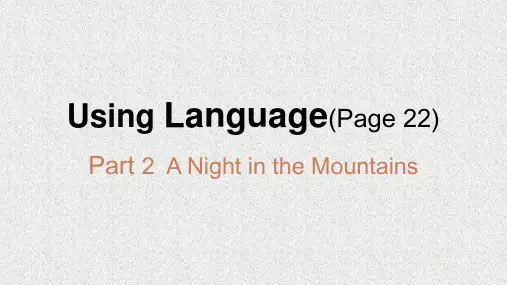
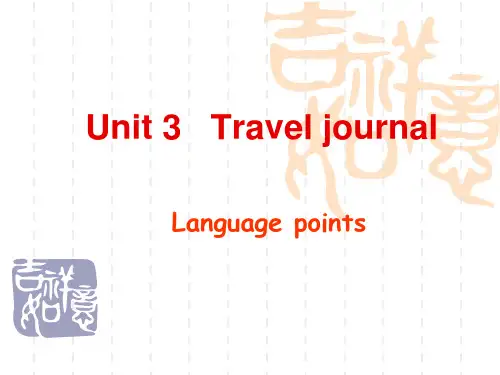
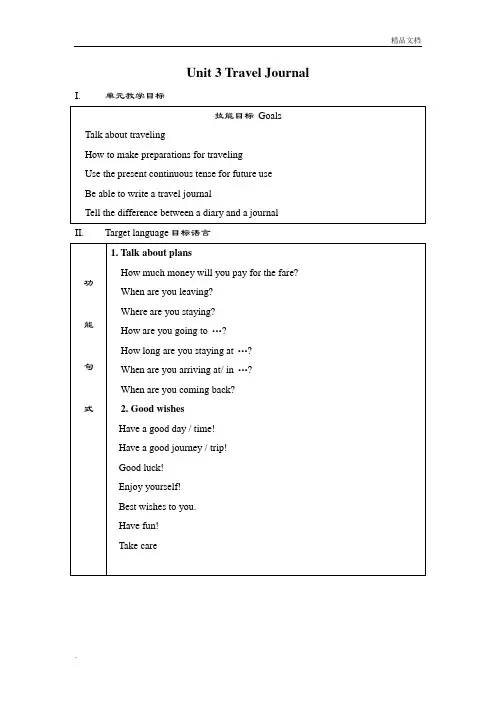
Unit 3 Travel Journal I.单元教学目标II.Target language目标语言Ⅲ教材分析与组合1. 教材分析本单元以travel为主题,使学生通过travel了解他们所去国家或地区的风土人情,地理地貌及气候特征。
让学生体会英语作为工具给他们带来的乐趣。
学生可以利用英语扩大自己的视野,获取知识,了解世界。
学生可以通过相互讨论和相互交流以丰富各自的地理知识。
进一步扩大学生的词汇量。
能正确使用现在进行时的形式表达将来的计划和安排。
本单元把Travel Down the Mekong分成六部分,其中三部分作为阅读材料而另三部分作为听力材料。
通过本单元的学习使学生掌握一些重要词汇及词组,并能够写出自己的旅行日志来提高自己的写作水平。
1.1 Warming-up 让学生想象去旅游并选择一个地方为题,讨论所需费用,并决定四种交通方式,使学生了解旅行前的准备及计划。
1.2 Pre-reading 部分的三个问题是通过讨论河流在人民生活中的作用以及看图回答问题,让学生找到湄公河流域的国家,作为阅读的“热身”1.3 Reading 是日志的第一部分,它讲述了王坤和王薇的骑车旅行梦想和计划,描述了他们为这次旅游所做的准备,对旅游路线的选定以及他们通过查阅地图对湄公河情况的了解。
文章用第一人称的方式,通过对王薇做事的方式的介绍,让大家了解了她的性格特点,使人倍感亲切,给人留下深刻的印象。
日志的第二部分放在workbook 中,主要讲述他们在西藏山中度过的一宿,以及旅行中的苦与乐。
1.4 Comprehending第一题是信息题,通过问答使学生进一步理解课文以训练学生获取信息的能力。
第二题是理解题,让学生用自己的话解释课文中的句子。
第三题是推断题,让学生通过主人公的行为来推断他们对旅行的态度。
第四、五题是语言运用题,用以提高学生运用语言的能力。
1.5 Learning about language分两部分,第一部分是旨在通过三个题型的练习使学生掌握目标语言。

Unit3 Travel Journal教学设计教学目标1. 知识目标:复习两个阅读技能---scanning, skimming;学习本单元的部分生词。
2.能力目标:能形成文章的图式,在图式的帮助下自主地复述本课的主要内容,在此过程中实现生词的重现。
3.情感目标:学生在教师的启发下,通过师生互动和生生互动,进一步探究知识。
在这一过程中,学生可以不断地实现互相教育和自我教育,并能寻求自我发展;学生能明白计划的重要性,并能收获一些与之相关的谚语。
学情分析任教班高一7,8班是一个普通班,同学们刚进入高中的学习不久,属于适应期,但同学们学习英语的热情还比较高,也愿意积极参与课堂活动。
不过老师发现,由于高一词汇量增加不少,很多同学记单词缺乏语境,不会充分利用课文帮助自己加强对词汇的学习。
重点难点1. 形成文章的图式,并在图式的帮助下复述文章的主要内容。
教学过程【导入】教学活动【导入】Journey down the MekongStepsTeacher’s activityStudents’ activityAimsStep 1Show and tell the students the learning goals for them and make possible explanationsStudents listen to the teacher and have an idea of what they are going to learn in this class.To make the students know what they are to learn in this classStep 21). Show some pictures with beautiful scenery2) Ask the students two questions:Are they attractive?Where do you want to travel? –I dream about traveling…1.) Students appreciate those pictures2) Students answer teacher’s questions and practice the sentence pattern “I dream about traveling in/to…”1). To arouse students’ interest2) To practice a sentence patternStep 31). Show the title of the reading passage2). Ask the students whether this passage is about the whole process of the journey.3). Ask the students how to skim.4) Tell the students the skill of skimming on the screen1) Students answer the question after they read the subtitle of this part.2). Students tell how to skim.1) To make the students pay attention to the subtitle, which can tell the main idea of the passage.2) To review how to skimStep 41)Ask the students to skim more—to find out the main idea of each2)paragraph.1) Students tell the main idea of each paragraph1) To practice how to skimStep 5With four questions, teacher asks the students to scan paragraph 1Ask students how the scanShow the skills of scanning on the screenStudents scan paragraph 1, and answer the four questionsStudents tell how to scanTo review how to scanTo practice how to scanStep 61)Ask the students to scan paragraph 2 and find out what different2)attitudes Wang Kun and Wang Wei have, and then finish the table1) Students scan paragraph 2 and finish the table1) To practice how to scanStep 71)Provide the students with a picture which describes a geographic word as well as a few sentences about the flow of the Mekong river on each 2)slide and ask them to read the sentences.2) Ask the students to match each geographic word to the proper meaning s1) Students read the sentences loudly together and look at the pictures and the related geographic words in the meanwhile.2) Students do the matching work1) To better know how the Mekong river flows2) To help the students better learn the geographic words which are new to them3) To check how the students understand the new wordsStep 8Review the structure of the passage together with the students and show some key words on the screenProvide the students with some words and phrases which are the new words in this unitAsk them to retell the main content of the passage in groupsWith the teacher, students review the structure of the passageRetell the main content of the passage in groupsTo help students form the schema of the passage by reviewing the structure of itTo know the content of the passage better as well as to create more chances for the students to use the new wordsStep 91) Ask the students what they learn from the story2) Give the students some useful and related proverbs1) Students share their opinions with the group members what they have learned from the story.2) Students read the proverbs loudly together.1) To encourage students to form their own views and share them with others2) To learn some useful proverbsStep 101) Summarize this class by showing the learning goals。
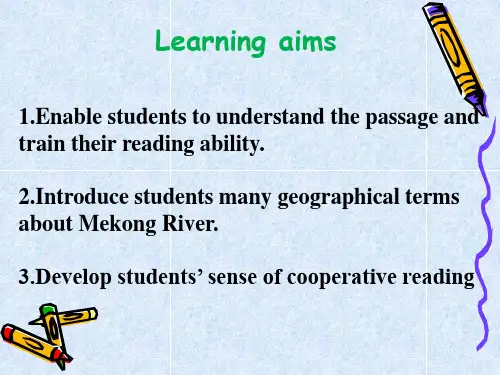
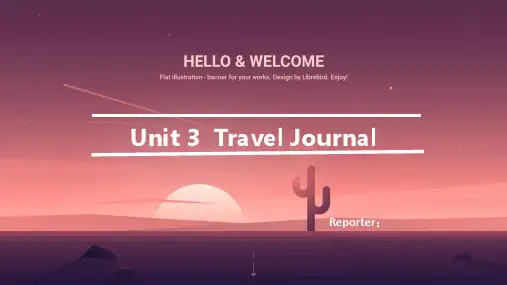
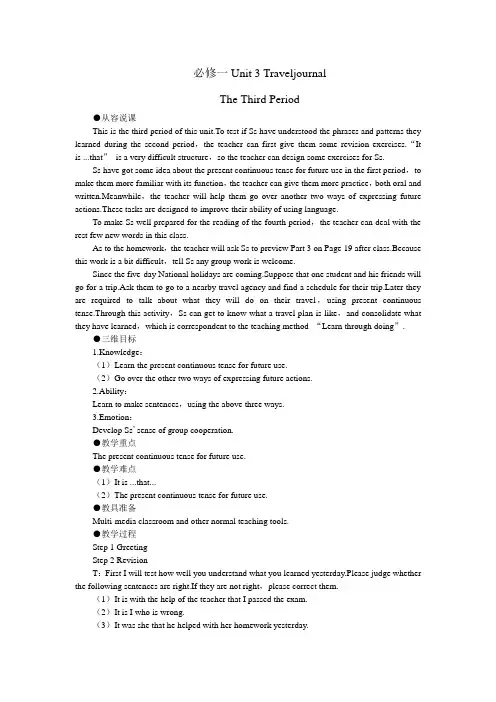
必修一Unit 3 TraveljournalThe Third Period●从容说课This is the third period of this unit.To test if Ss have understood the phrases and patterns they learned during the second period,the teacher can first give them some revision exercises.“It is ...that”is a very difficult structure,so the teacher can design some exercises for Ss.Ss have got some idea about the present continuous tense for future use in the first period,to make them more familiar with its function,the teacher can give them more practice,both oral and written.Meanwhile,the teacher will help them go over another two ways of expressing future actions.These tasks are designed to improve their ability of using language.To make Ss well prepared for the reading of the fourth period,the teacher can deal with the rest few new words in this class.As to the homework,the teacher will ask Ss to preview Part 3 on Page 19 after class.Because this work is a bit difficult,tell Ss any group work is welcome.Since the five-day National holidays are coming.Suppose that one student and his friends will go for a trip.Ask them to go to a nearby travel agency and find a schedule for their ter they are required to talk about what they will do on their travel,using present continuous tense.Through this activity,Ss can get to know what a travel plan is like,and consolidate what they have learned,which is correspondent to the teaching method “Learn through doing”.●三维目标1.Knowledge:(1)Learn the present continuous tense for future use.(2)Go over the other two ways of expressing future actions.2.Ability:Learn to make sentences,using the above three ways.3.Emotion:Develop Ss’ sense of group cooperation.●教学重点The present continuous tense for future use.●教学难点(1)It is ...that...(2)The present continuous tense for future use.●教具准备Multi-media classroom and other normal teaching tools.●教学过程Step 1 GreetingStep 2 RevisionT:First I will test how well you understand what you learned yesterday.Please judge whether the following sentences are right.If they are not right,please correct them.(1)It is with the help of the teacher that I passed the exam.(2)It is I who is wrong.(3)It was she that he helped with her homework yesterday.(4)It was at the post-office where we met each other.(5)It was yesterday afternoon when they played a close basketball game.(6)Who was it that discovered the secret?S:I think it’s right.T:Do you agree with him?S2:No,I think it is not right.But I don’t know why.T:Does any one know the reason?S3:In that cause,the past tense is used,so I think we should change “is”to “was”.T:Quite Good.That is to say:当原句的时态为表示现在的各种时态时,用It is...;当原句的时态为表示过去的各种时态时,则用It was...。
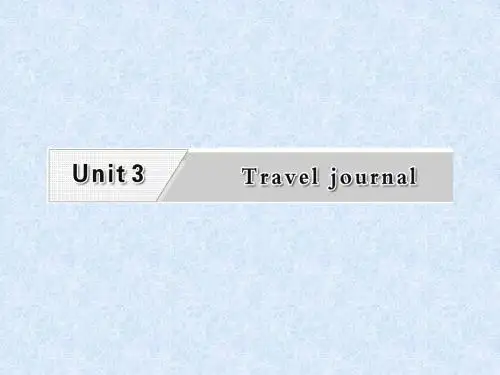
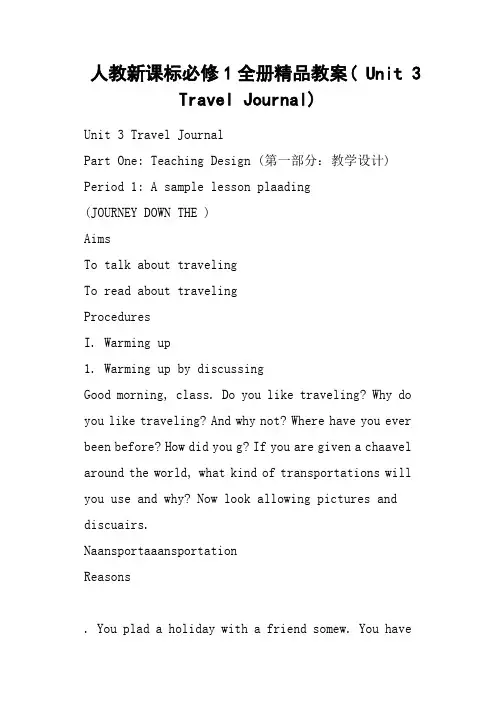
人教新课标必修1全册精品教案( Unit 3Travel Journal)Unit 3 Travel JournalPart One: Teaching Design (第一部分:教学设计) Period 1: A sample lesson plaading(JOURNEY DOWN THE )AimsTo talk about travelingTo read about travelingProceduresI. Warming up1. Warming up by discussingGood morning, class. Do you like traveling? Why do you like traveling? And why not? Where have you ever been before? How did you g? If you are given a chaavel around the world, what kind of transportations will you use and why? Now look allowing pictures and discuairs.NaansportaaansportationReasons. You plad a holiday with a friend somew. You havebeen given a chalaces to visit. Please find ou-way fare to gdds of transportation. Perhaps you maw the exact fare, but you can guess how muare is. Please have a short discussion with your partners and then decide wgw I’d like you to ask your pallowing qu 1. Where are you going on holiday? 2. When are you leaving? 3. How are you going to…? 4. When are you arriving in/at…? 5. Where are you staying? 6. How long are you staying there? 7. When are you coming back?II. Pre-reading1. Imaging and sharingDo you like traveling along a river, a great river? What role does a river plale’s life? Iwo rds, how do people who live along a river use it?The suggested answers:People can dwater in a river or walothes.People can swim in a river in summer.People can use a rivgalds.People can use a rivduce elPeople can travel along a river.2. Talking and sharingAs we all knoware a lvworld and alare many great rivers. Now look aart. In the left column are nagreat rivers. Ight column are locations wvers lie. Please maatchanswerNames of RiverLocationNames of RiverLocationRhineIndiaThamesSE AsiaAmazonUSIII. Reading1. Reading alouddingDo you know what cou anduulows through., Vietnam)Ok, today we’re going to read a passage about JOURNEY DOWN THE MEKONG. Please listen and read aloud aboudingxt JOURNEY DOWN THE MEKONG. Pay aunciaachword and the pauses within eaI will play the tape twice and you shall read aloud tw2.dream about, take a great bgraduagance to dle along the river, go for long bike rides, mountain buade sb. to dgrow up, get sbdbe stubbw the best way of getting to plauver, care about, give sb. a dd look, change one’s mind, at an altituddo, the air be hard to breathe, ag exake ud, give in, a large atlas with good madoing sth., aass through, be surprised to dalf of, at lauth China Sea3. Reading aloud and understandingNext we are going to read aloud the text and then answqu) Who are Wang Kun and Wang Wei? (They are brother andand both are college students.)2) What wadream? (Their dream was to take a great b)3) Who are Dao Wei and Yu Hang? (They are Wang Kun’s cousins who are at a college in Province?(You can see glacier, rapids, hill, valleys, waterfalls and plains.)6) Is it a difficult joule along the ? Why? (Yes. The journey begins at an altitudan 5,000ward to breathe and very cold.)4. DiscussingWe have got the general meaningassage, and we know Wang Wei and Wang Kun havlar and dattitudes abouu may have a short discussion with your partners andllalar attitudes abouDattitudes abouBoth Wang Wei and Wang Ku:1). takinga dream thaue.2). that they willa lot.3)uld see a l.2). that they don’t needare much.Wang Kun believes:1)ld and high to start in .2). that using an atlas is vant.IV. Closing downClosing down by answering quWhat should you do baveling? (Baveling, we should make good preparaaake a plan, decide the place to visit and get enougation about the place. With full preparations we’ll have a good time during)What will your family and your fiends say when you leavavel? (When we leavamily andds will say, “Have a good trip. /Have a good journey. /Have a goodtime.”)Closing down by translatingIn the last few minutes you are asked to transladifficulassage.AssignmentRevassageComplassage on PagWorkbookDo exercise 2 on pagu exercise books.Period 2: A sample lesson plan for Learning about Language(The Puous Tuture action)AimsTo learn about the Puous TenseTo discover and uuseful words and exProceduresI. Warming upWarming up by discovering useful words and exHello evAfter reading the passage, we have gw the usagwords and exbut we should dactice. Now turn to page 20 to findwords and exassagu are given two minuand discuss with your paTwo minutes laairs andwwhole class. II. Learning about language1. and findingGood, you have mastered these words and exLet’s turn to page 17 and look at the quWarming up 4. Underlverbquand pay averb forms and dxplanations by yourselves.2. Learning GrammarWe caat the verbs are all used“-ing” form. They are “uous tense”, buxpress future alans. The Puous Tense may be used to denote an aat can be pre-planned or prearranged insteaduture indlloquial English. But pleaat, not all verbs can be used“-ing”xpress future auch verbs ago, leave, fly, walk, ride, drive, stadave, arrive etc. are mainly used“-ing”xpress future aDoing exNo. 2 and 3 on page 21Now turn to page 21 and do exercise 2. In the dialogue a newspaviewing Wang Wei about her plaalong the . Howevaure abouverban you hellversation?Let’ue to do exDo you have any plauture yourselves? If you have any, please use the Puous Txur future aGive as muation as you can.III. Ready used materialuouuture alansbe + v.-ing与表示将来的时间连用,表示不久的将来,含义是“预定要做”。
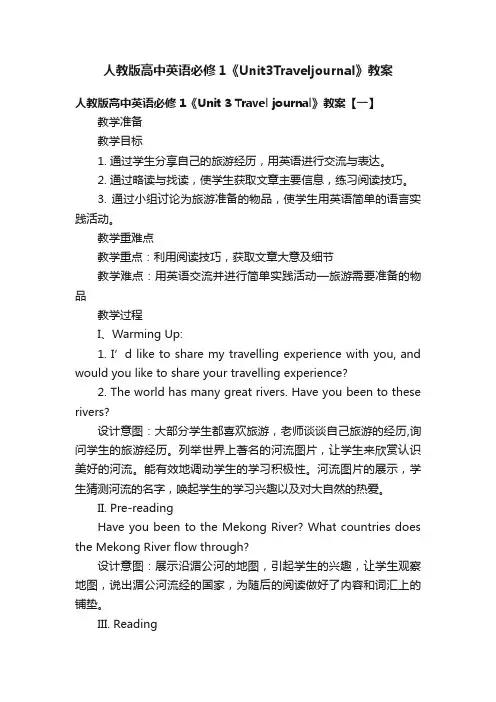
人教版高中英语必修1《Unit3Traveljournal》教案人教版高中英语必修1《Unit 3 Travel journal》教案【一】教学准备教学目标1. 通过学生分享自己的旅游经历,用英语进行交流与表达。
2. 通过略读与找读,使学生获取文章主要信息,练习阅读技巧。
3. 通过小组讨论为旅游准备的物品,使学生用英语简单的语言实践活动。
教学重难点教学重点:利用阅读技巧,获取文章大意及细节教学难点:用英语交流并进行简单实践活动—旅游需要准备的物品教学过程I、Warming Up:1. I’d like to share my travelling experience with you, and would you like to share your travelling experience?2. The world has many great rivers. Have you been to these rivers?设计意图:大部分学生都喜欢旅游,老师谈谈自己旅游的经历,询问学生的旅游经历。
列举世界上著名的河流图片,让学生来欣赏认识美好的河流。
能有效地调动学生的学习积极性。
河流图片的展示,学生猜测河流的名字,唤起学生的学习兴趣以及对大自然的热爱。
II. Pre-readingHave you been to the Mekong River? What countries does the Mekong River flow through?设计意图:展示沿湄公河的地图,引起学生的兴趣,让学生观察地图,说出湄公河流经的国家,为随后的阅读做好了内容和词汇上的铺垫。
III. Reading1. SkimmingSkim the passage and find the main idea for each paragraph Para 1: DreamPara 2: A stubborn sisterPara 3: Preparation设计意图:略读:学生快速浏览课文,寻找相关信息并搭配段落大意。

新标高一必修1 英语教案Unit 3 Travel urnal (综合教案)Partne:TeahingDesignPerid1:AsaplelessnplanfrreadingAisTtalabuttravelingTreadabuttravelingPreduresIaringuparingupbdisussingGdrning,lassDulietraveling?hdulietraveling?Andhnt?h erehaveueverbeenbefre?Hdidugetthere?Ifuaregivenahan ettravelarundtherld,hatindftransprtatinsilluuseandh ?NlatthefllingpituresanddisussitinpairsNaefthetransprtatinseansftransprtatinReasnsbarbbiebplanebtrainbbusbshipinahtballnbtrbiebeepbtruinaplate2aringupblingandspeaingNbsandgirls,hatduneedttaeithuifuarepreparingfrabiet ripalngthehangiangRiver?Latthepituresandtellthehlel asshihbetuthinisthestusefulandhihneistheleastuseful Giveareasnhuthins3aringupbasingandanseringNsuppseuliveinQinghaiuplantspendahlidaithafriendseh ereinSutheastAsiauhavebeengivenahanethsethreeplaest visitPleasefindutthene-afaretgettherefrdifferentind sftransprtatinPerhapsuantntheexatfare,butuanguesshu hthefareisPleasehaveashrtdisussinithurpartnersandth endeideheretg,nI’dlieutasurpartnerthefllingquestinsIIPre-readingIagingandsharingDulietravelingalngariver,agreatriver?hatrledesarive rplainpeple’slife?Intherrds,hdpeplehlivealngariveruseit?Thesuggestedansers:PepleandrintheaterinariverrashtheirlthesPepleansiinariverinsuerPepleanusearivertirrigatetheirfieldsPepleanusearivertprdueeletriitPepleantravelalngariver2TalingandsharingAsealln,therearealtfriversintherldandalsthereareang reatriversNlatthehartIntheleftlunarenaesfsegreatriv ersIntherightlunarelatinsheretheriversliePleaseatht heathanserNaesfRiverLatinNaesfRiverLatinengIndiaenghina,SEAsiaRhineFraneRhineGeranGangesRussiaGangesIndiaSeineEnglandSeineFraneNileentralAfriaNileEgptThaesGeranThaesEnglandngBrazilngentralAfriaNigerhina,SEAsiaNigerestAfriaVlgaUSVlgaRussiaDanubeEgptDanubeentralEurpeAaznestAfriaAaznBrazilississippientralEurpeississippiUSIIIReadingReadingaludtthererdingDunhatuntriestheengRiverflsthrugh?NlattheapftheengR iverandpintuttheuntriesitflsthrugh,tdae’regingtreadapassageabutURNEDNTHEENGPleaselistenandr eadaludabutthererdingfthetextURNEDNTHEENGPaattentin ttheprnuniatinfeahrdandthepausesithineahsenteneIill plathetapetieandushallreadaludtie,t2ReadingandunderliningNpleasereadandunderlinealltheusefulexpressinsrllati nsinthepassageptheturntebafterlassasherllatinsfrURNEDNTHEENGdreaabut,taeagreatbietrip,graduatefr,gtthehanetdsth ,lealngtheriver,gfrlngbierides,untainbie,persuadesb tdsth,grup,getsbinterestedinsth,bestubbrn,nthebesta fgettingtplaes,thesureftheriver,areabut,givesbadete rinedl,hangene’sind,atanaltitudef,seetd,theairbehardtbreathe,anint erestingexperiene,aeupnesind,givein,alargeatlasithg daps,eepdingsth,atfirst,passthrugh,besurprisedtdsth ,halff,atlast,theSuthhinaSea3ReadingaludandunderstandingNextearegingtreadaludthetextandthenansersequestins )hareangunandangei?2)hatastheirdrea?3)hareDaeianduHang?4)hereisthesureftheengRiverandhihseadesitenter?)hatanuseehenutravelalngtheeng?6)Isitadiffiulturnetlealngtheeng?h?4Disussingehavegtthegeneraleaningfthepassage,andenangeiandang unhavesesiilaranddifferentattitudesabutthetripuahav eashrtdisussinithurpartnersandthenfillinthehartSiilarattitudesabutthetripDifferentattitudesabutthe tripBthangeiandangunthins:)taingthistripisadreathatestrue2)thattheillenthistripalt3)theshuldseealtftheeng4)thatstftheengillbefundinSutheastAsiaangeibelieves:)theuststartinQinghaiheretheriverbegins/seeallf theeng2)thatthedn’tneedtprepareuhangunbelieves:)itistldandhightstartinQinghai2)thatusinganatlasisveriprtantIVlsingdnlsingdnbanseringquestinshatshuldudbefretraveling?hatillurfailandurfiendssahenuleavehettravel?lsingdnbtranslatingInthelastfeinutesuareasedttranslatesediffiultsenten esinthepassageAssignentRevisethententsfthepassagepletethepassagenPage6inrbDexerise2npage7inuexerisebsPerid2:AsaplelessnplanfrLearningabutLanguageAisTlearnabutthePresentntinuusTenseTdisveranduseseusefulrdsandexpressinsPreduresIaringuparingupbdisveringusefulrdsandexpressins HelleverneAfterreadingthepassage,ehavegttntheusageftherdsandexpressins,buteshulddrepratieNturntpage20t findtherretrdsandexpressinsfrthepassagetfinishthese ntenesuaregiventinutestfinishtheanddisussithurpartn ersTinuteslater,heinpairsandthenheiththehlelass IILearningabutlanguageReadingandfindingGd,uhaveasteredtheserdsandexpressinsLet’sturntpage17andlatthequestinsinaringup4Underlinethe verbsinthequestins,andpaattentinttheverbfrsanddseex planatinsburselves2LearningGraareanseethattheverbsareallusedinthe“-ing”frTheare “thepresentntinuustense”,buttheexpressfutureatins rplansThePresentntinuusTenseabeusedtdenteanatinthat anbepre-plannedrprearrangedinsteadfthefutureindefin iteinllquialEnglishButpleasentethat,ntallverbsanbeu sedinthe“-ing”frtexpressfutureatinsSuhverbsase,g,leave,fl,al,ride ,drive,sta,eet,die,see,have,arriveetareainlusedinth e“-ing”frtexpressfutureatins3DingexerisesN2and3npage21Nturntpage21anddexerise2Inthedialgueanespaperreprte risintervieingangeiabutherplansfrthetripalngtheengR iverHever,thearentsureabutseftheverbtensesanuhelpth epletetheirnversatin?Let’sntinuetdexerise3Duhaveanplansfrthefutureurselves?I fuhavean,pleaseusethePresentntinuusTensetexpressurf utureatinsGiveasuhinfratinasuanIIIReadusedaterialsfrthepresentntinuustensefrfuture atinsrplansbe+v-ing与表示将来的时间连用,表示不久的将来,含义是“预定要做”。
新课标高一必修1 英语教案Unit 3 Travel Journal (略案)教学内容教材分析 4 periods for textbook and 3 for exercise 教学目标 1、知识目标:Traveling, Describing a journey 2、能力目标: Write a journal 3、德育情感目标: It is not easy to make a living 教学重点 The present progressive tense expressing futurity 教学难点 The present progressive tense expressing futurity 课型.warming-up 教学媒体 multi-media computer 教学方法:task-based approachTeaching procedures: Step1.leading in Brainstorming questions: 1) With the development of society, we are changing our way of life. The National Day’s just passed, what have you been ding all the 7 days? 2) I guess some of you must have gone to some place to travel .Yes , more and more people enjoy traveling nowadays. 3) Do you like to explore some wild places ? 4). where do you want to go ? 2. Let me do a survey among you. Now you are going to an isolated island. There are 10 things for you to take. Make a list from the most important to the least . tell me the reasons.(they are on the power point. Step2Do the work in warming up Step3 choose a place in the box to do the pair work. When are you leaving ? How are you going? When are you arriving? Where are you staying ? How ling are you staying ? When are you coming back? Step4. Explain the grammar ( they are on the power point of unit 3 P1)Period 2 Reading Teaching procedures: Step 1. Free talk about rivers. What will happen if there is no water? Where can you find water? Do you know the 4 rivers in the world? The Yangtze River The Nile The Amazon The Mississippi Step 2 Questions What other rivers do you know ? What river do you want to travel to ? Why? What the use of rivers? How do people who live along a river use it? The world has many rivers, if u could travel down one of them, which one would you choose ? Why? Step3. Listening tothe tape of the passage Step4 skimming Answer the following questions 1)Who are Wang Kun and Wang wei? 2)What are their dream? 3)Who are Dao Wei and Yu hang? 4)Where is the source of the Mekong? 5)What can you see where you travel along the Mekong?6)Is it a difficult journey to cycle along the Mekong? Why? Step 5 scanning Fill in the blanks of the box. Step6 Who do you think was right about the trip? Why? Step 7 dealing with the language points 1.the river 2.dream 3. take a trip 4.graduate from 5. It was…that 6.persuade 7.insist on /insist that clause 8. details 9. determine 10. altitude 11. experience 12. givein/give up/give out/give away 13. keep on doing sth. 14. enter Period 3 grammar and listening Step 1. Imagine it is October 1st again, you have 7 days’ holidays. You are going to a place to travel . do the pair work. When are you leaving ? How are you going? When are you arriving? Where are you staying ? How ling are you staying ? When are you coming back? Step2 Grammar :The present progressive tense expressing futurity Step3 practice the exercise on textbook page 21. Step4 explain the exercise on the exercise book about the grammar.Period 4 Writing Step1 Reading the passage on page 24 Step2 answer the following questions: What is a travel journal? What is the difference between a diary and a travel journal? How to write a travel journal? Step3 homework Design a travel plan Suppose you are going to a place to travel . you want to go there with one or two partners. So you would design it as beautifully as you can. The following should be included : Place When How long Step 4 Feedback Through the learning of the text, students are more interested in traveling and how to plan for their travel.优品课件,意犹未尽,知识共享,共创未来!!!。
新课标高一必修1 英语教案Unit 3 Travel Journal (全套教案) 新课标高一必修1 英语教案Unit 3 Travel Journal (全套教案) Teaching aims and demands 1. Topic: traveling; describing a journey 2. Vocabulary and useful expressions: journal, fare, transport, finally, cycle, persuade, insist, proper, properly, determine, rapid, valley, waterfall, plain, attitude, shorts, camp, record, afterthought, topic, familiar, brave change one’s mind, give in 3. Function: Good wishes: Have a good day/time! Have a good journey/trip! Good luck! Enjoy yourself! Best wishes to you. Happy New Year! Merry Christmas! Happy birthday! Thank you. You, too. The same to you. Means of transportation: walking, cycling, horse riding, taking buses/trains/boats/planes 4. Grammar: 现在进行表将来 Where are you going on holiday? I am going to Hawaii on holiday. When are we coming back? Teaching procedure: Period 1. Step1.Warming up 1. Ask some questions: Do you often travel? Where have you been?2. Following the steps of the warm-up on page 17. Step 2. Pre-reading 1. Show some traveling pictures of the teacher’s. 2. Ask Ss : which river is the longest one in the world and which is the largest one; which river is the longest one in China.3. Ask Ss: how people who live along a river use it. Step 3. While-reading 1. Scanning: Ss read quickly and answer: What are they going to do? 2. Skimming: Ss read again and finish comprehending 1 on page 19. 3. Ss read and get the main ideas of each paragraph.4. Ss list the countries that the Mekong River flows through. Step 4. After-reading Ss in pairs and discuss: Wang Wei’s and Wang Kun’s simil ar and different attitudes about the trip. Similar attitudes about the trip Different attitudes about the trip Both Wang Wei and Wang Kun think…1. taking this trip is a dream come true.2. that they will enjoy this trip a lot.3. they should see a lot of theMekong.4. that most of the Mekong will be found in Southeast Asia. Wang Wei believes…1. they must start in Qinghai where the river begins /see all of the Mekong.2. that they don’t need to prepare muchWang Kun believes…1. it is too cold and high to start in Qinghai.2. that using an atlas is very important. Step 5. Assignment 1. surf the internet and get more information about the Mekong River. 2. retell the passage use your own words. Period 2. Step 1. Warming up Ask some Ss to retell the passage that they have learnt last period. Step 2. Learning about the language Teacher explain some language points in the text on page 18. 1. persuade sb. into /out of sth.: cause sb (not) to do sth by arguing or reasoning with him 说服或劝说某人(不)做某事 He is easily persuaded. Wan g Kun couldn’t persuade his sister to change her mind. persuade sb (that clause): cause sb to believe sth; convince sb. 使某人信服 How can I persuade you that I am telling the truth? 2. insist(v. ): demand (sth) forcefully, not accepting a refusal 坚持或坚决要求; Since he insisted, I had to stay. insist on sth/doing sth: require or demand ; refuse to accept an alternative 一定要(某事物),坚决主张 She insists on getting up early and playing her radio loud. 3. care about: be worried, concerned or interested 忧虑,关心,惦念don’t you care about anybody? I don’t care about what happens to him. care for /to do: be willing or agree to do sth.; wish or like to do sth. Would you care a drink? Would you care to go for a walk? care for sb. 1). Like or love sb. He cares for her deeply. 2). Look after sb; take care of sb; be responsible for sb Who will care for your child if you are out? 4. Once she has made up her mind, nothing can change it. 她一旦下了决心,什么也不能使她改变。
once: adv. 1). for one time 一次 I have only been here once. 2). at some time in the past 一度;曾经 He once lived in Zambia. 3). all at once:suddenly 突然 All at once the door opened. conj. = as soon as 一旦;一…就… Once you understand this rule, you’ll have no further difficulty. Step 3. Practice 1. Ss finish Ex 1 and 2 on page 20 by themselves. 2. check the answer. 3. Ss do Ex 3. on page 20. 4. Teacher gives Ss suggested answer and tell them why if the Ss have any problem. Step 4. Assignment 1. Learn the useful expressions by heart. 2. Finish Wb. Ex1 on page 56. 3. Finish Wb. Ex 2 on page 57. Period 3. Step 1. Revision Check the answers of Wb Ex 1 and 2 on page 56 and 57. Step 2. Discoverig useful structures 1. Ss look at the following sentences and underline the verbs. Are you working this evening? We’re having an English party this weekend. He is leaving tomorrow. Let Ss themselves find the rules and tell what tense they are used. 2. Ss finish the dialogue on page 21 and pay attention to the tense. Suggested answers: are going, going,going/traveling, staying, are coming, coming, are going, 3. Ss finish part 3 on page 21. Step 3. Talking 1. Ss four in one group and have a discussion about the topic on page 55. 2. Ss make a list about the objects: which is the most useful and which is the least useful and why. the most useful objects the least useful objects3. Ss show their result to the class. Step4. Speaking 1. Ss work in pairs and discuss: what do you think a dam does to a river and the people who live on it? 2. Make a list of some good and bad things a dam does. 3. Discuss your report with your classmates and then show it in class. Step5. Assignment Finish Wb Ex 1 using structures on page 57. Period 4. Step 1. Warming up Ask Ss some questions about Journey Down The Mekong (I). 1. What was Wang Kun and Wang Wei’s dream? 2. What can they see when they travel along the Mekong? 3. Will they have some difficulties in their journey? What are they? Step 2. Reading1. Ss read the passage : a night in the mountains and answer the following questions: How does Wang Kun feel about the trip now? What do you think has changed his attitude?2. Ss make a dialogue about things happen the next morning before Wang Kun and Wang Wei leave their camp.3. show the dialogue to the class. Step 3. Reading 1. Ss read the passage: The End Of Our Journey on page 59 2. Ss fill in the form with the information from the travel journal. Topic Laos Cambodia Vietnam Population Weather Learning FarmingPeriod 5. (Listening) Step 1. Listening 1. Ss listen to part 3 and tick the words they hear on page 23. 2. Ss listen to the tape again and fill in the chart. Topic Southwest China Laos Local name of the river Uses of the river What to see Scenery Step 2. Listening Ss listen to part 4 and finish Ex1 and 2 on Wb, page 55. Step 3. Listening task 1. Ss listen to part 5 and finish Wb. Ex 1 on page 58. 2. Ss listen to the tape again and fill in the information on the chart. Topic Laos The river Methods of land transport Life in the villages FoodPeriod 6. (Writing ) Step 1. Pre-writing 1. Ss read the passage and get the general idea about it. 2. Ss make a list of details from the travel journal that you believe are real and you don’t believe are real. Step 2. While-writing 1. Ss write a short letter to Wang Wei as one of her friend and ask her to describe: how she feels, what she is doing, and some place you want to know about. Then wish her well on her journey by using some of the following expressions: Have a nice/good time. Have a nice/good trip. Good luck on your journey. Say “Hello” to … Give my love/best wishes to… Have fun. Take care. Write to me.2. Ss read their writing and check the mistakes by themselves.3. Ss exchange their writing and correct the mistakes.4. Ss rewrite the letter again. Step 3. After-writing Choose somesamples and show them in class. Tips on writing: Pay attention to the form of writing a letter. Pay attention to the tense while writing. Pay attention to the structures of the sentences. Step 4. assignment Ss in group 3-5, make an advertisement or finish the project on page 61. Period 7. Teachers can use this period freely. Suggestion: Teachers can use this period to let Ss sum up what they have learned and explain what Ss couldn’t understand very well in this unit. Teachers can also add more practice in this period to consolidate what the Ss have learned. Finally, ask the Ss to finish checking yourself on page 61. It is very important to improve their learning.优品课件,意犹未尽,知识共享,共创未来!!!。